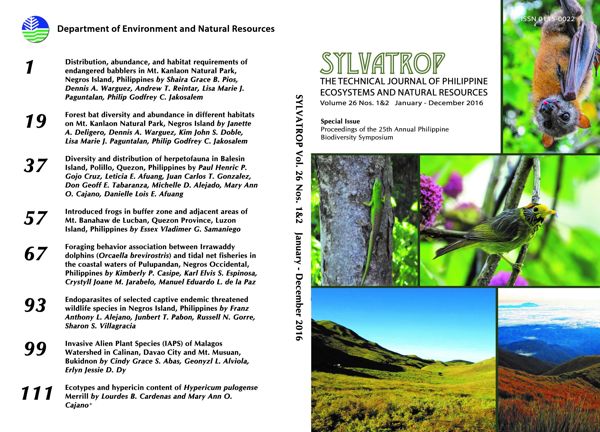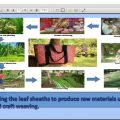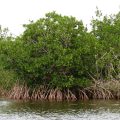The government has pressed for the conservation of endangered “Zosteropidae” bird babblers in Negros Island as biodiversity preservation has become crucial to rural economy’s sustainable development.
The babblers at the Mt. Kanlaon Natural Park in Negros Island are threatened by bird hunting, illegal cutting for timber, firewood and charcoal production, human-induced air pollution, and conversion of forest to agricultural commodities, according to the Sylvatrop Journal of the Ecosystems Research & Development Bureau (ERDB)

In Sylvatrop’s special issue with the Biodiversity Conservation Society of the Philippines, experts revealed both Negros babblers—the flame-templed babbler (Dasycrotapha speciosa, endemic to Negros and Panay) and Negros-striped babbler (Stachyris nigrorum, endemic to Negros) have been classified as endangered by IUCN (International Union for Conservation of Nature).
As of 2015, BirdLife International indicated that the population of D. speciosa in Mt. Kanlaon ranged at 2,500-9999 individuals.
This was greater than the 600-1,700 mature individuals for S. nigrorum.
Reduction in population, threatened at 50-90%, of the bird species is believed to be continuing.
“(We should) intensify regular forest monitoring in Mt. Kanlaon; establish and revisit biodiversity monitoring system for population of babbler species,” according to Sylvatrop authors Andrew T. Reintar, Shaira Grace B. Pios, and Dennis A. Warguez.
They also pressed for conservation initiatives to start and education materials to raise public awareness on the biodiversity threat.
ERDB Director Dr. Henry A. Adornado said that the study increases understanding of the status of Philippine biodiversity.
“These efforts are aligned with ERDB’s mission to provide science-based information for the improvement of our environment. May these scientific information inspire us to work hard for the conservation of our rich flora and fauna,” Adornado said.
Biodiversity protection promotes sustainable development of forests that are significant sources of food, timber and non-timber products, and raw materials for manufacturing supplies while generating livelihood for rural people.
“We need biodiversity for its invaluable ecosystem services, providing oxygen, food, clean water, fertile soil, medicines, shelter, protection from storms and floods, a stable climate and recreation,” according to the Earth Institute.
The IUCN itself recommended more surveys in Panay and around Mt. Silay and Mt. Mandalagan in north Negros to locate other birds.
It pushed for the establishment as protection area of the proposed Central Panay Mountains National Park and other key sites as the North Negros Forest Reserve.
“This lowland forest species has a very small, severely fragmented and declining range. It is estimated that just 10% of remaining forest on the two islands where it occurs lies within the elevation range suitable for this species,” said IUCN.
Reforestation is a solution to their threatened extinction.
According to the study, “Tree density was found to be significant in the abundance of S. nigrorum; a decrease in tree density would mean an increase in the abundance of S. nigrorum.
This result strongly presses the fact that the species prefers mid-montane and mossy forest”.
Thick undergrowth should be developed for D. speciosa which is an omnivore. These babblers feed and breed in understory bushes, trees, vines, and ferns.
According to the IUCN, while conservation sites have been identified, there has been no species management that successfully reintroduced the population, no awareness-education program, and no action recovery plan or monitoring. Needed protection includes site protection and management and habitat and natural process restoration.
Surveys in 1991 yielded tentative estimates of 22 D. speciosa per square kilometer on Mt. Kanlaon, although only a few square kilometres of suitable forest remain.
In 1987, D. speciosa was discovered in Panay Island. D. speciosa is also now known to dwell in five localities in the Panay central mountains, although “it appears very uncommon and/or has a very patchy distribution,” according to IUCN report.
The bird babblers’ status was only threatened as of 1988. The IUCN has a six-stage Red List classification from least concern to extinct in the wild.
About 80 species of the bird babblers have already become extinct or critically endangered out of 678 recorded species and 206 endemic.
And as birds are easier to monitor, it becomes an indicator of the status of other animals.
“The threatened extinction of bird species implies comparable losses in other groups and hence a major reduction in biodiversity,” according to the results published in the Sylvatrop journal.
The study also found out that D. speciosa was most likely to be found at lower elevations from 400 meters above sea level (masl) to 900 masl. On the other hand, the higher elevations were occupied by S. nigrorum between 1,000 masl to1,800 masl.
Also found in secondary lowland forest, mixed forest plantation, and plantation were the D. speciosa because these are really lowland forest dwelling, and S. nigrorum birds are more upland birds.
In the study in an expanse of 44-kilometer path between 400-800 masl, 22 D. speciosa and no S. nigrorum were found. In the middle elevation, of 850-1450 masl, five D. speciosa and 10 S. nigrorum were found. On the high elevation of between 1,450-1800 masl, four S. nigrorum and no D. speciosa were found.
Threats of tree cutting and charcoal production were numerous in Sitio Minoyan,Brgy Wasay and Murcia, Negros Occidental.
“Other threats such as butterfly collection and snare traps for medium-sized mammals are evident throughout Sitio Minoyan, Barangay Wasay, Murcia and Guintubdan, Barangay Ara-al, La Carlota City in Negros Occidental.”
The Sylvatrop authors also pressed for the study to be published in peer-reviewed journals so that the research results can be shared in the scientific community. (Growth Publishing for ERDB)

For any questions or interview requests, please contact 0929-715-8669, 0917-102-6734






